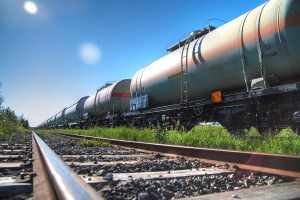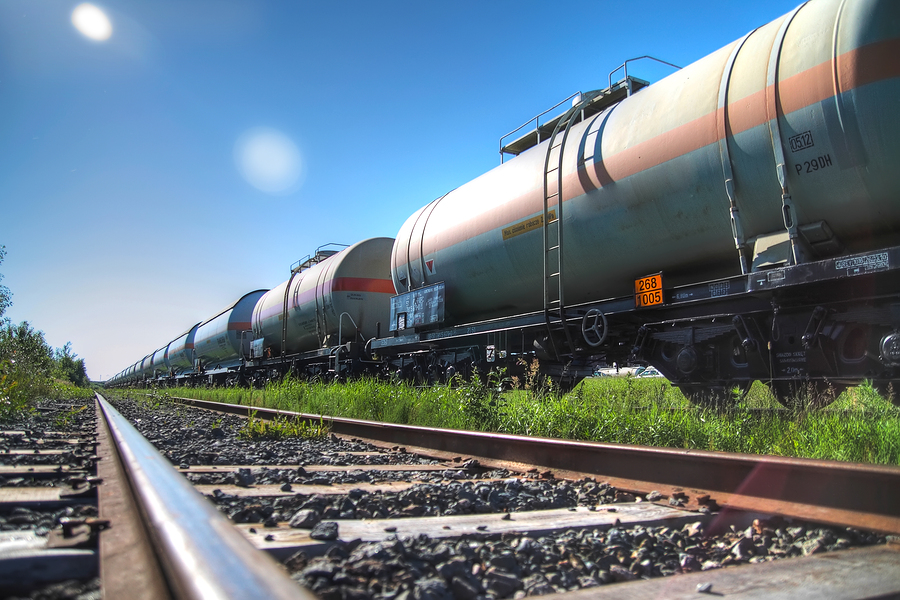The oil industry and the railroads that haul its crude have offered U.S. regulators a joint plan to phase out a type of older tank car tied to a spate of fiery accidents, according to two people familiar with the proposal.
The plan also calls for slightly thicker walls for new cars to make them less vulnerable to puncture, according to the people, who asked not to be identified discussing private communications. The parties agreed to scrap a fleet of thousands of DOT-111s within three years if manufacturers agree they can replace or retrofit the tank cars in that period.
Representatives of the American Petroleum Institute and the Association of American Railroads met with officials of the Transportation Department and Office of Management and Budget on July 11 to present their plan, one of the people said.
The joint plan represents a change from recent history, where oil companies and railroads have sparred over design and safety proposals. Rail companies said new tank cars were needed, while oil companies stressed greater attention was needed to avoid derailments. The Transportation Department had encouraged the groups to forge a common position.
U.S. regulators, along with their counterparts in Canada, are weighing steps that can be taken to increase the safety of trains moving oil by rail in the wake of a number of accidents, including a wreck a year ago in Quebec that killed 47.
Investment Needed
Transport Canada in April mandated a three-year phase-out of tank cars ordered before October 2011, when the industry introduced a car design to include shields at the ends and protection for valves on the top. The agency also immediately banned tank cars that have weak underbelly support, those built before the mid-1990s, from carrying dangerous goods.
The deal between API and the railroad group also would require that new cars be built with a half-inch steel shell, or 1/16th of an inch thicker than newer car designs now being produced, known as the CPC-1232.
Officials from the Washington-based API and AAR didn’t respond to requests for comment. API’s members include Exxon Mobil Corp. AAR represents companies such as Berkshire Hathaway Inc.’s BNSF railway. Ryan Daniels, a spokesman for the Transportation Department, said he can’t comment on a continuing rulemaking.
Oil Boom
If adopted by federal officials, the industry plan would require a significant investment by oil and leasing companies that own rail cars. GATX Corp. of Chicago is among the largest owners of tank cars with about 4,600 in crude and ethanol service, according to an April 29 filing. Greenbrier Companies Inc., headquartered in Lake Oswego, Oregon, manufactures the cars.
Until recently, trains didn’t carry much oil. That changed with a big jump in domestic production that outpaced the capacity of pipelines to carry the fuel.
As many as 10 trains with 100 or more tank cars filled with crude leave North Dakota, home to a booming oil and natural gas industry, every day for refineries across the U.S. Carloads of oil jumped to 408,000 last year from 11,000 in 2009, according to the railroad group.
“We’re seeing exponential growth in the transport of crude oil by rail,” Transportation Secretary Anthony Foxx said in Washington on July 1 at a breakfast sponsored by the Christian Science Monitor. “It requires us to step up our level of safety as a nation.”
A year ago, an unattended train broke free from its brakes and rolled into Lac-Megantic, Quebec, creating a fireball that killed 47 people and incinerated much of the downtown area.
DOT-111
Subsequent derailments and explosions of trains in North Dakota and Virginia that didn’t cause causalities led to heightened concern about using trains to haul oil in the U.S.
The accidents have focused attention on the design of thousands of older tank cars, known as the model DOT-111, that the National Transportation Safety Board said are vulnerable to rupture. Those cars are still in wide use today.
The U.S. Transportation Department has taken interim steps to respond to what it’s called an imminent hazard.
In February, it reached an agreement with railroads to slow oil trains to 40 miles per hour through urban areas from 50 mph and install sensors to detect faulty track.
In May railroads agreed to give local officials more information on crude shipments routed through their communities.
Tank car owners have balked at the cost, estimated as high as $60,000 each, to modify tank cars to new specifications. The cost wasn’t clear for the design agreed to by API and AAR.
The AAR had been backing a plan to require a tank car shell 9/16th of an inch thick. The one settled on with oil companies instead calls for a half-inch shell.
In an interview before reaching the agreement, Edward Hamberger, chief executive officer of the AAR, said there was a need to balance risk with the need to move the oil.
“Where do you draw that line? We have that challenge every day,” Hamberger said. “What is the need for commerce? What is the need for having a tank that actually has some capacity? You could make them a foot thick and then have them carry three gallons each. There will always be some risk.”
Was this article valuable?
Here are more articles you may enjoy.


 Waymo to Update Software Across Fleet After Major Power Failure
Waymo to Update Software Across Fleet After Major Power Failure  Cat Bonds Linked to Wildfires Lose ‘Once Untouchable’ Status
Cat Bonds Linked to Wildfires Lose ‘Once Untouchable’ Status  Insurance AI Demo Day Calendar Announced
Insurance AI Demo Day Calendar Announced  Twice Injured Firefighter Loses Second Workers’ Compensation Claim
Twice Injured Firefighter Loses Second Workers’ Compensation Claim 